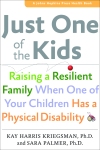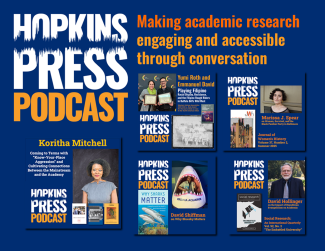Among her many activities, JHU Press author Sara Palmer serves as chair of the board of Baltimore's League for People with Disabilities. Recently, we came across the League's charming and inspiring addition to the flood of "Happy" videos based on the Pharrell Williams hit song. And that, in turn, inspired us to invite Sara and co-author Kay Kriegsman to reflect on their career-long focus on people with disabilities and their families. We are pleased to share their thoughts along with the video.
[embed]http://www.leagueforpeople.org/mp4/LFP_720x404.mp4[/embed]
Guest post by Kay Harris Kriegsman and Sara Palmer
Over the years, we’ve had the privilege of working in our practices, at workshops, and at national conferences with many families that include children with and without physical disabilities. These families were always eager for suggestions, ideas, and resources to help all their children become productive, happy adults.
Just One of the Kids: Raising a Resilient Family When One of Your Children Has a Physical Disability was written specifically for these “mixed bag” families. Numerous parents (and grandparents, and siblings with and without a disability) shared their perspectives in extensive interviews with us; we sifted through them to find the “gold nuggets”—tools these families developed and used effectively—and to identify the tools and resources they were searching for in their quest to raise healthy, happy children prepared for successful adulthood.
Just One of the Kids brings together the wisdom of these families, our years of clinical experience, and the work of other disability experts. Equally important, the book is informed by our personal perspectives as people (one with a disability and one without) who are professionals, mothers, grandmothers, family caregivers, disability advocates, and enthusiastic participants in social, leisure, and creative activities. We would like to tell you who we are, how we’ve worked together, and what else we do in the world of disability and beyond. Along the way, you’ll find links to a variety of disability organizations that may be useful to your children or family. There are many more of these resources in the book.
Kay’s Story
I always wondered as a child, “What’s the big deal about having a physical disability?” I did the same things my brothers did, albeit from a sitting stance or using crutches and braces, after a bout with polio at age 7. We all played musical instruments, were active in 4-H, did assigned chores, helped care for two younger sisters born many years later, and had the usual childhood fights.
Although I had physical therapy, operations, and doctors’ appointments, I was also just one of the kids, included and needed in the larger family scene. Disability was just one of the challenges my family faced, the chief one being economic upheaval. This was hard on the family, but had a positive side for me, as it took the focus off my disability and meant that I had to be a contributing member of the family. I washed dishes, set the table, and vacuumed while sitting on the floor.
I was not aware as a child how my disability affected my parents. While my family treated me like any other child, it wasn’t always easy. My mother still remembers that just after I was airlifted from our small mountain town to a big-city hospital, the head of the hospital billing office was disdainful and made her feel incompetent because our family had no health insurance. My brothers felt the effects of my eight-month hospitalization. Like other children during the polio epidemics, my brothers were quarantined in the first few weeks of my illness . And when I returned home from the hospital, my family had new responsibilities to shoulder. Getting on with life meant adding new activities, like the daily physical therapy exercises my mother had to help me with.
In the years following, I never heard my family say that I could not do something. If there were a student council meeting on the second floor of a building without an elevator, they found a way for me get there; usually my brothers “bumped” me up the steps in my wheelchair. It was expected that I would ask a boy to the school dance, go on 4-H trips, and drive a car at age 16. My family encouraged me to take risks, though they weren’t always comfortable with what I was ready to do. Although I walked with crutches everywhere except through my high school’s busy hallways (where I used a wheelchair), my family expected me to use my wheelchair at college for safety and to conserve my energy. I refused—the wheelchair took the ride over the Continental Divide to my university, where I stowed it away in the basement of the dorm.
My parents made a choice to see what I could be rather than what I could have been. They must have felt sad when their 7-year-old girl, who loved dancing and “running the hills” with her brothers, had to use double leg braces and crutches to walk. But they never conveyed a sense that they saw me as anything but an equal to my brothers and sisters.
The acceptance and equal treatment by my family shaped my attitudes about physical disability and my interest in helping other families raise hearty, independent-minded kids—whether or not they have a physical disability. In addition, it provided the confidence and skills I would need in my marriage, parenting, building my psychology practice and pursuing my passion for painting. With the love and support of my late husband, Will, I returned to graduate school for a PhD in counseling while raising our children, Bill and Katie. For many years I co-directed the annual HOW (Handicapped Is Only a Word) Conference for teenagers who have physical disabilities, their parents, and their teen siblings. HOW emphasized opportunities for socialization, peer support, future planning, and fun. This inspired me to coauthor the book
Taking Charge: Teenagers Talk about Life and Physical Disabilities.
In 2000, Sara and I coauthored
Spinal Cord Injury: A Guide for Living, also published by JHU Press, and I published articles on disability in professional journals and consumer magazines. I have facilitated workshops for parents, young adult,s and children at the
Spina Bifida National Conferences; I wrote numerous columns for their
Insights publication, including “Ask Dr. Kay.”
Osteogenesis Imperfecta Foundation’s summer conventions were another wonderful venue for meeting and working with families; I contributed chapters to books for parents and medical professionals on OI. I’ve also worked with the
National Cerebral Palsy Foundation, the
Muscular Dystrophy Association, and the
National Spinal Cord Injury Association. In my private psychology practice, I work with people, both able-bodied and who have disabilities, going through the normal ups and downs of life.
In addition to my art work, I find great joy in being with my grandchildren. I especially love taking them on weekend trips and taking one “big” trip alone with each grandchild, whether a cruise, visiting a theme part, or going on a road trip (travel resources are available in
Just One of the Kids).
Sara’s Story
I grew up able-bodied in a family that was not directly affected by physical disability. Much of my experience with disability comes from my work as a rehabilitation psychologist, helping people who have disabilities and their partners and families cope with difficult circumstances and live more fulfilling lives. My perspective has been enlarged over the past several decades by my personal experience as a family caregiver for several relatives who had disabilities or chronic illnesses.
I learned nothing about physical disability in my clinical psychology graduate program. But my husband,
Jeffrey Palmer, M.D., then a medical student, was interested in physical medicine and rehabilitation. Through him, I was introduced to the field of rehabilitation psychology, met more people who had disabilities, and was inspired to explore this new career path. During my internship at the Seattle VA Hospital, I spent three months on the inpatient rehabilitation unit, evaluating and treating people with spinal cord injuries, strokes, amputations, and other disabilities. I found it refreshing to work with people who were generally mentally healthy but coping with the emotional fallout from a life-changing accident or illness. Colleagues often asked me if it was depressing to work with people who had such “tragic” circumstances, but I felt uplifted by the strength and creativity I saw in my patients as they discovered ways to cope with their disabilities and reengage in life. Since then, I have worked in hospital, university and private practice settings—with rehabilitation psychology as my focus across the board.
In 1987, I had the task of recruiting another rehabilitation psychologist to work with me in a group practice. A few phone calls led me to Kay, who traveled to my office for an interview. We had instant rapport as professionals and became “friends at first sight.” Kay had more life experience and I had more clinical experience. But we were both fairly new psychologists, bursting with ideas; and through our relationship, we were able to develop and express them. We shared clinical insights and strategies to help our clients, created continuing education programs for other psychologists, and started the first
Disability Committee of the Maryland Psychological Association, advocating for inclusion of psychologists with disabilities. After completing two editions of our book on spinal cord injury, we got to work on some new ideas.
In 2011, while Kay was conducting initial interviews for
Just One of the Kids, I worked with Jeffrey on
When Your Spouse Has a Stroke: Caring for Your Partner, Yourself, and Your Relationship. I continue to write articles and webinars on family caregiver issues for the
National Stroke Association, and I spoke regularly at stroke fairs and stroke support groups.
My passion for rehabilitation extends to my volunteer work as a board member (and current Board Chair) for the League for People with Disabilities (www.leagueforpeople.org), a multi-service organization serving people with disabilities in Maryland for over 85 years. The League provides individualized, person-centered services to adults and children and is committed to advocacy and inclusion of people with all types of disabilities. It’s a privilege for me to work with the League, where ideals of fostering abilities, self-expression, independence and the pursuit of happiness are realized. A video’s worth a thousand words, and
this one, starring League participant Adam Carpenter, says it all.
In my free time, I enjoy writing poetry, knitting sweaters for my new grandson, reading, and fitness. I practice yoga and love to ride my bike and take nature walks. I belong to two book clubs and my e-reader is never far from reach. I spend as many hours as possible with my family and my amazing friends. My friendship with Kay is a rare and precious blend of mutual affection, respect, honesty, humor, and intellectual collaboration, spanning over 25 years—from which I have learned an enormous amount about life with (and without) a physical disability.
 Kay Harris Kriegsman, Ph.D., is a practicing psychologist, consultant on disability issues, and author of
Kay Harris Kriegsman, Ph.D., is a practicing psychologist, consultant on disability issues, and author of Taking Charge: Teenagers Talk About Life & Physical Disabilities
. Sara Palmer, Ph.D., is an assistant professor in the Department of Physical Medicine and Rehabilitation at the Johns Hopkins University School of Medicine. They are coauthors of Just One of the Kids: Raising a Resilient Family When One of Your Children Has a Physical Disability and, with Jeffrey B. Palmer, M.D., and Spinal Cord Injury: A Guide for Living.



